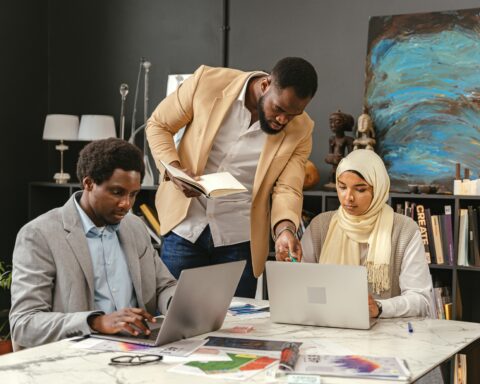Immigrating to a new country can put a strain on a person’s mental health and well-being. Art therapy, one of the disciplines being recognized in November as part of arts and health month, can have positive benefits for newcomers’ mental health.
“Moving to another country can be an exciting experience, but it can also be nerve-racking or sad,” explains art therapist Debbie Anderson. “Art making can help people find the inner peace that they may have lost in the migration process.”
According to Arts Health Network Canada (AHNC), arts and health is an interdisciplinary field that embraces different forms of art to promote health, prevent diseases and enhance health service delivery. There are multiple arts and health initiatives available across Canada.
AHNC’s communications coordinator, Zara Contractor, mentions that the World Health Organization (WHO) defines health as an individual’s complete physical, mental, social, emotional and spiritual well-being, and not only as the absence of disease.
“The arts can positively impact all these dimensions in different ways,” Contractor says.
https://www.youtube.com/watch?v=T68D1MlIF5Q
Video By: Samantha Lui for New Canadian Media
Art as therapy
Contractor highlights the importance of making a distinction between expressive or creative arts therapies from other arts and health practices within the field.
Expressive art therapy focuses on art making as a therapeutic process, while other arts and health practices focus on engaging people in the arts for reasons such as enjoyment, education, distraction from illness, social connection and self-exploration.
Different materials and techniques, such as colouring, painting, collage, clay and weaving are used in expressive art therapy.
“People may think that they are not artists, but everybody can use art as a means of expression.”
Moreover, expressive art therapies are regulated by professional associations and require a postgraduate or master’s degree.
Mehdi Naimi, president of the Canadian Art Therapy Association (CATA), explains that only qualified art therapists graduated from programs regulated by specific standards can practise this profession in Canada.
Tzafi Weinberg, CATA’s advocacy chair, explains that emphasis is placed on safety, confidentiality and unconditional acceptance in a non-judgemental atmosphere throughout the whole therapeutic process.
She adds that the focus of the therapy is not the final product, but the creation process instead. For this reason, no previous experience in art is required.
“People may think that they are not artists, but everybody can use art as a means of expression,” says Jannika Nyberg, co-founder of ArtQuake, a grassroots organization that connects young people through the arts in Vancouver.
For this reason, Nyberg encourages everyone to try different artistic forms. “In this way, you may realize that you enjoy these activities and that they can be a positive outlet to deal with your emotions.”
Benefits for newcomers
The sessions in art therapy can be individual or in a group. While some people can feel more comfortable in individual sessions, group sessions can contribute to creating a sense of community and allowing interaction with people from different backgrounds.
“They also offer a space to find collective support, input and understanding,” explains Tanissa Martindale, a recent art therapy graduate and the registrar and practicum coordinator of the Winnipeg Holistic Expressive Arts Therapy Institute (WHEAT).
“Art has allowed me to express my longing for my family and my country, and to explore my journey and my identity.”
According to Anderson, group sessions can be particularly beneficial for newcomers because by sharing their stories, people discover that they have similar experiences as others, and share attributes of resilience and strength.
Newcomers can bring their own culture into the session through the use of symbols, materials, and images that are familiar to them.
Therapists do not interpret the artwork in this process. Instead, they guide the individuals to find its meaning.
“People are their own experts, they know what they need and all the answers are within them,” says Weinberg.
Hana Pinthus Rotchild, a registered social worker and art therapist working with different populations including immigrants and refugees, explains that this approach allows people to recreate the reality they left behind and process any grief or anxiety they may be experiencing.
Through different art projects, she has reflected on her own migration process from Israel to Canada in 2003.
“Art has allowed me to express my longing for my family and my country, and to explore my journey and my identity,” she shares. “It has also been an avenue to cope with my losses, separations, and transitions, while helping me to stay connected with my roots.”
Non-verbal methods of expression
People of all ages suffering from different conditions like depression, grief, anxiety, trauma and eating disorders can benefit from art therapy.
Anderson explains that this is possible because non-verbal methods can be effective in helping people express themselves.
By encouraging individuals to make art instead of talk about their own emotions and ideas, art therapy can provide gentle, healthy and positive communication outlets and coping mechanisms.
“In art therapy, people can express through their own visual voice without the need of words.”
This can also break the language barrier that newcomers may face.
“In art therapy, people can express through their own visual voice without the need of words,” says Pinthus Rotchild.
Naimi explains that once people express what cannot be said through other mediums, they find relief, process their experiences, improve their self-esteem and envision the future they want for themselves.
“In this way, art therapy encourages therapeutic healing and creative problem solving,” he adds.
For Nyberg, art has also been a means for personal transformation.
“Art is the one place where I can get out of my mind and into my body to express and process my emotions,” she says. “If I didn’t have that outlet, I don’t know where all those emotions would have gone.”
Belen Febres is a Phd Candidate at Simon Fraser University with a focus on Community Media and Health Communication. Belen collaborates with historically silenced communities and communication initiatives to co-create spaces for self-representation and social change.





